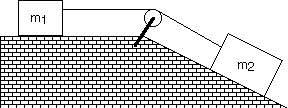Collected Problems for Test 2
Problem #9 (Due 2/15 Wednesday by 2:00 p.m.)
A duck has a mass of 2.5 kg. As the duck paddles, a force of 0.10 N acts on it in a direction due east. In addition, the current of the water exerts a force of 0.20 N in a direction of 52o south of east. When these forces begin to act, the velocity of the duck is 0.11 m/s in a direction due east. Find the magnitude and direction (relative to due east) of the displacement that the duck undergoes in 3.0 s while the forces are acting. Make sure you draw a nice force diagram of the duck - you only need to draw in the horizontal forces (a top view of the duck).
Problem #10 (Due 2/16 Thursday by 2:00 p.m.)
A block is projected up a frictionless inclined plane with initial speed vo = 3.50 m/s. The angle of incline is q = 32.0o.
a) Draw a free body diagram of the block and sum forces.
b) How far up the plane does the block go?
c) How long does it take to get there?
d) What is its speed when it gets back to the bottom?
Problem #11 (Due 2/17 Friday by 2:00 p.m.)
In the diagram three boxes are connected by cords, one of which wraps over a pulley having negligible friction on its axle and negligible mass. The three masses are mA = 30.0 kg, mB = 40.0 kg, and mC = 10.0 kg. The assembly is released from rest.
a) What is the tension in the cord connecting B and C?
b) How far does A move in the first 0.250 s?

Problem #12 (Due 2/22 Wednesday by 2:00 p.m.)
Four identical masses of 800 kg each are placed at the corners of a square whose side length is 10.0 cm. What is the net gravitational force (magnitude and direction) on one of the masses, due to the other three?
Problem #13 (Due 2/23 Thursday by 2:00 p.m.)
In the diagram, block 1 of mass 2.0 kg and block 2 of mass 3.0 kg are connected by a string of negligible mass and are initially held in place. Block 2 is on a frictionless surface tilted at q = 30.0o. The coefficient of kinetic friction between block 1 and the horizontal surface is 0.25. The pulley has neglibible mass and friction. Once they are relleased, the blocks move. What then is the tension in the string?

Problem #14 (Due 2/24 Friday by 2:00 p.m.)
The drawing shows a baggage carousel at an airport. The suitcase has not slid all the way down the slope and is going around at a constant speed in a circle (r = 11.0 m) as the carousel turns. The coefficient of static friction between the suitcase and the carousel is 0.760, and the angle q of the carousel with respect to the horizontal is 36.0o. How much time is required for your suitcase to go around once?

Problem #15 (Due 2/29 Wednesday by 2:00 p.m.)
A net force with magnitude (5.00 N/m2)x2 and directed at a constant angle of 31.0o with the +x-axis acts on an object of mass 0.250 kg as the object moves parallel to the x-axis. How fast is the object moving at x = 1.50 m if it has a speed of 4.00 m/s at x = 1.00 m?
Problem #16 (Due 3/1 Thursday by 2:00 p.m.)
The engine of a car with mass m supplies a constant power P to the wheels to accelerate the car. You can ignore rolling friction and air resistance. The car is initially at rest.
a) Starting with P = dW/dt, show that the speed of the car is given as a function of time by v = (2Pt/m)1/2.
b) Show the acceleration of the car is not constant, but is given as a function of time by a = (P/2mt)1/2.
c) Show that the displacement as a function of time is given by x - xo = (8P/9m)1/2t3/2.
Problem #17 (Due 3/2 Friday by 2:00 p.m.)
A child plays on a swing having support ropes that are 2.20 m long. A friend pulls her back until the ropes ar 42o from the vertical and releases her from rest.
a) How fast will she be moving at the bottom of the swing?
b) How much work does the tension in the ropes do as the child swings from the initial position to the bottom?
c) How fast is the child moving when it swings up to an angle of 32o on the other side of the vertical?